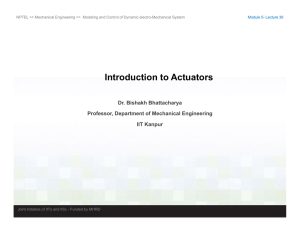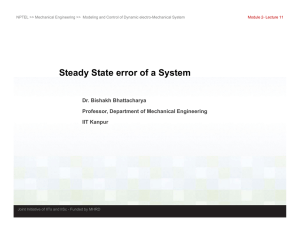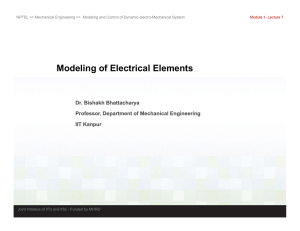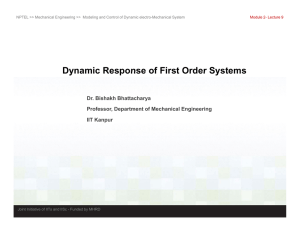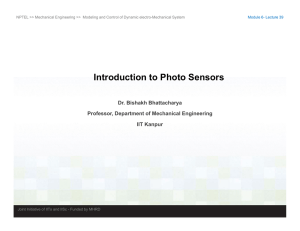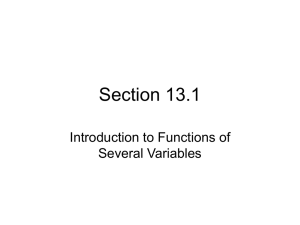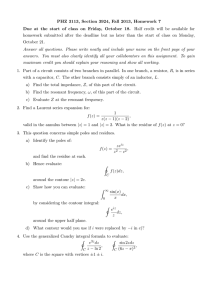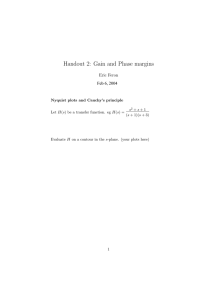Nyquist Stability Criteria
advertisement
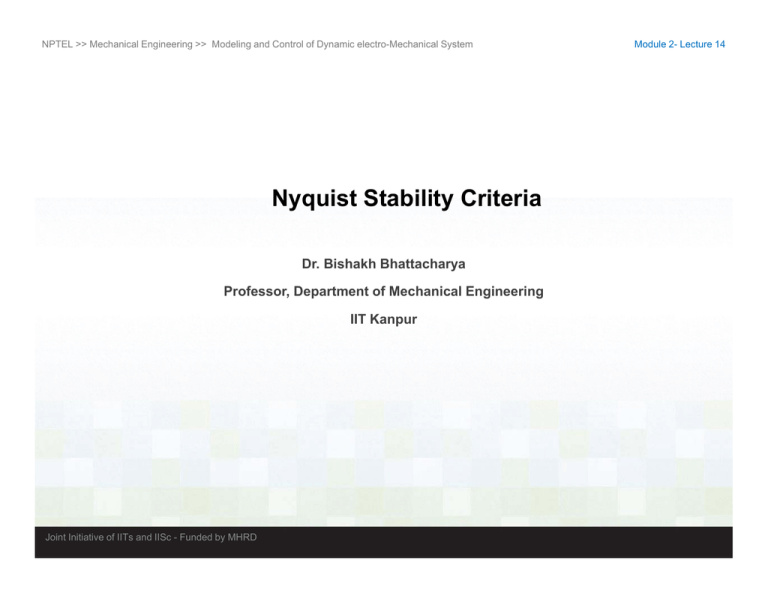
NPTEL >> Mechanical Engineering >> Modeling and Control of Dynamic electro-Mechanical System Nyquist Stability Criteria D Bishakh Dr. Bi h kh Bhattacharya Bh tt h Professor, Department of Mechanical Engineering IIT Kanpur Joint Initiative of IITs and IISc - Funded by MHRD Module 2- Lecture 14 NPTEL >> Mechanical Engineering >> Modeling and Control of Dynamic electro-Mechanical System This Lecture Contains Introduction to Geometric Technique for Stability Analysis Frequency response of two second order systems Nyquist Criteria Gain and Phase Margin of a system Joint Initiative of IITs and IISc - Funded by MHRD Module 2- Lecture 14 NPTEL >> Mechanical Engineering >> Modeling and Control of Dynamic electro-Mechanical System Module 2- Lecture 14 Introduction In the last two lectures we have considered the evaluation of stability by mathematical th ti l evaluation l ti off the th characteristic h t i ti equation. ti R th’ test Routh’s t t and d Kharitonov’s polynomials are used for this purpose. There are several geometric procedures to find out the stability of a system. These are based on: Nyquist Plot Root Locus Plot and Bode plot The advantage of these geometric techniques is that they not only help in checking the stability of a system, they also help in designing controller for the y systems. Joint Initiative of IITs and IISc ‐ Funded by MHRD 3 NPTEL >> Mechanical Engineering >> Modeling and Control of Dynamic electro-Mechanical System Module 2- Lecture 14 Nyquist Plot is based on Frequency Response of a Transfer Function. Consider N i t Pl t i b d F R f T f F ti C id two transfer functions as follows: T1 ( s ) s5 s5 ; T ( s ) 2 s 2 3s 2 s2 s 2 The two functions have identical zero. While for function 1, the poles are at ‐1 and 2 respectively; for function 2 the poles are at +1 and 2 Let us excite both and ‐2 respectively; for function 2, the poles are at +1 and ‐2. Let us excite both the systems by using a harmonic excitation of frequency 5 rad/sec. The responses of the two systems are plotted below: Stable Frequency Response of T1 Unstable Frequency Response of T2 NPTEL >> Mechanical Engineering >> Modeling and Control of Dynamic electro-Mechanical System Module 2- Lecture 14 Frequency Domain Issues Consider a closed loop system of plant transfer function G(s) and Feedback transfer function H(s) respectively. respectively The closed loop transfer function corresponding to negative feedback may be written as: G ((ss ) T (s) 1 G (s) H (s) Poles of 1+G(s)H(s) are identical to the poles of G(s)H(s) Zeroes of 1+G(s)H(s) are the Closed Loop Poles of the Transfer Function If we e ta take e a Co Complex p e Number u be in tthe e ss-plane pa ea and d subst substitute tute itt into to a Function F(s), it results in another Complex Number which could be plotted in the F(s) Plane. NPTEL >> Mechanical Engineering >> Modeling and Control of Dynamic electro-Mechanical System Module 2- Lecture 14 Cauchy Criteria Mapping: A Clockwise contour in the s-plane results in Clockwise contour in the F(s) plane if it contains only zeros A Clockwise contour in the s-plane results in anti-Clockwise contour in the F(s) plane if it contains only poles If the contour in the s s-plane plane encloses a pole or a zero, it results in enclosing of the origin in the F(s) plane NPTEL >> Mechanical Engineering >> Modeling and Control of Dynamic electro-Mechanical System Module 2- Lecture 14 Example: p A Clockwise Contour in the s-plane p for G(s) ( ) = s-z1 Reference: Nise: Control Systems Engineering NPTEL >> Mechanical Engineering >> Modeling and Control of Dynamic electro-Mechanical System Module 2- Lecture 14 Example: A clockwise contour around a Right-half Plane Pole for a function G(s) = 1/(s-p 1/(s p1 ) Reference: Nise: Control Systems Engineering NPTEL >> Mechanical Engineering >> Modeling and Control of Dynamic electro-Mechanical System Module 2- Lecture 14 Nyquist yq Stability y Criteria – Number Number of Counterclockwise (CCW) rotation N of Counterclockwise (CCW) rotation N = P Pc – Zc (Pc – no. of enclosed poles of 1+ G(s)H(s) and Zc – no. of enclosed zeroes) – For a Contour in s‐plane mapped through the entire right half o a o ou s p a e apped oug ee e g a plane of open loop transfer function G(s) H(s), the number of closed loop poles Zc (same as the open loop zeros) in the right half plane equals the number of open loop poles Pc in the right half plane minus the number of counterclockwise revolution N around the point ‐1 of the mapping. – Z c= Pc ‐ N NPTEL >> Mechanical Engineering >> Modeling and Control of Dynamic electro-Mechanical System Consider a plant transfer function G(s) as follows: 2 s 12s 24 G(s) 2 s 8s 15 For a unity y feedback closed loop, p, find using g Nyquist yq Criteria whether the system will be unstable at some values of K. (Vary K from 0.5 to 10) Module 2- Lecture 14 NPTEL >> Mechanical Engineering >> Modeling and Control of Dynamic electro-Mechanical System Module 2- Lecture 14 The Nyquist diagram corresponding to unity Gain and the root locus are shown below for your reference. Nyquist Diagram Root Locus 0.4 0.3 0.3 0.2 0.2 Imaginary Axis (seconds-1) 0.4 Imaginary Axis 0.1 0 -0 1 -0.1 System: tf1 Gain: 0 0.51 51 Pole: -6.63 Damping: 1 Overshoot (%): 0 Frequency (rad/s): 6.63 0.1 0 -0.1 -0.2 -0.2 -0.3 -0.3 -0.4 -10 -0.4 04 -1 -0.5 0 0.5 1 1.5 -8 2 -6 -4 -2 0 2 Real Axis (seconds -11) Real Axis Joint Initiative of IITs and IISc ‐ Funded by MHRD 11 NPTEL >> Mechanical Engineering >> Modeling and Control of Dynamic electro-Mechanical System Gain Margin g The gain margin is the factor by which the gain can be raised such that the contour encompassed the unity point resulting in instability of the system. Following the figure below, gain margin is the inverse of the distance shown in the figure. shown in the figure. Module 2- Lecture 14 NPTEL >> Mechanical Engineering >> Modeling and Control of Dynamic electro-Mechanical System Phase Margin g The Phase Margin is the amount of phase that needs to be g p added to a system such that the magnitude will be just unity while the phase is 1800 . The figure below is showing ‘theta’ to be the phase margin. Often control engineers consider a system to be 0 q y p g adequately stable if it has a phase margin of at least 30 . Module 2- Lecture 14 NPTEL >> Mechanical Engineering >> Modeling and Control of Dynamic electro-Mechanical System Module 2- Lecture 14 Special References for this lecture Control Engineering and introductory course, Wilkie, Johnson and Katebi, PALGRAVE Control Systems Engineering – Norman S Nise, John Wiley & Sons Modern Control Engineering – K. Ogata, Prentice Hall Joint Initiative of IITs and IISc ‐ Funded by MHRD 14
